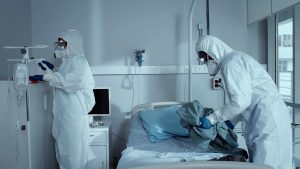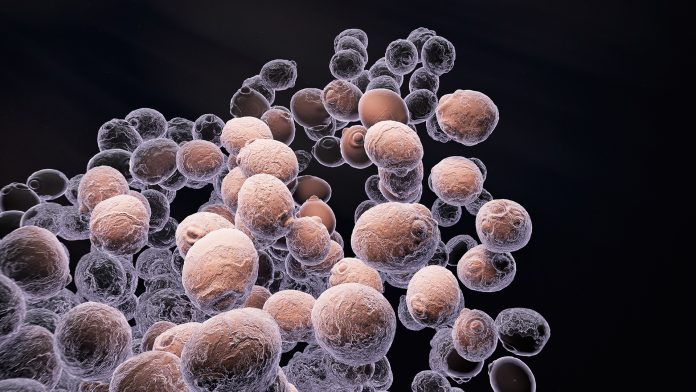Candida auris is an urgent, worldwide threat to human health. AvantGuard has a three-pronged approach to combat that threat.
Candida auris is unique among other pathogenic yeasts in causing large, intractable outbreaks in healthcare settings. Candida auris (C. auris) is a drug-resistant fungi that, unlike normal fungi, grows at human body temperature and in saline conditions and can rapidly colonise the skin of immuno-compromised patients. Colonised patients have up to a 20% chance of getting infected and infected patients have a >30% mortality rate in 30 days.1-3
To make matters worse, C. auris has the ability to shed into the environment, persist on inanimate surfaces for prolonged periods, and resist or rebound quickly from routine disinfectants.4,5 The minimum contact time to colonise a patient or contaminate a surface is about 4 hours.2 In the United States, long-term acute care hospitals and ventilator-capable skilled nursing facilities are particularly vulnerable, with colonisation prevalence in some facilities exceeding 70%.6-8
There is currently no protocol for de-colonising C. auris on patients and the standard of care, 2% chlorhexidine gluconate (CHG) daily bathing, has not been show to effectively de-colonise skin.9,10 With caseloads increasing by around 70% every year in the US, it is little wonder that C. auris is the first fungal pathogen to be listed by the U.S. Centers for Disease Control and Prevention as an urgent threat and as a critical priority by the World Health Organization.
Part of a bigger problem
A perfect storm is brewing in worldwide infectious diseases. Healthcare-acquired infections cost society $25-40bn a year, and the WHO predicts that by 2050, more people will die from drug-resistant pathogens than cancer. Right now, fungal infections afflict over a billion people every year and will only get worse with climate change. Our body’s main defence against fungi is our body temperature, which is normally too high for fungi to grow. Unfortunately, as the planet warms fungi are likely to accommodate themselves to higher temperatures, as C. auris already has.
AvantGuard’s innovation, a bio-inspired treatment
To develop a novel solution, perhaps the best approach is to start with how our bodies defend themselves. Our white blood cells kill pathogens by taking chlorine from salt in our body and attaching it to the amino acid taurine to make taurine chloramine. The resulting taurine chloramine compound is, essentially, a human biocide that kills a broad spectrum of pathogens, bacteria, viruses, and fungi, without resistance generation. Because of limited shelf-life stability, taurine chloramine has been relegated to only working inside our bodies.
AvantGuard, Inc., a Cornell University spinout founded in 2019, has developed a new compound called Avantamine™, which creates a stable chloramine compound that can be used as an antiseptic outside our bodies. Avantamine has all the benefits of taurine chloramine: broad-spectrum efficacy, quick kill, and no resistance generation, but it has a three-to-five-year shelf life.

AvantGuard is on a mission to replace the use of topical antibiotics so that current antibiotics will be useful for longer. Most people think of antibiotics as a pill they take, but some antibiotics are used topically to kill bacteria and fungi. Treating skin disorders and replacing antibiotics is a $30bn market opportunity that will create a healthier and safer world. However, Avantamine is versatile and can also be used as a disinfectant or residual disinfectant that will remain on surfaces to keep them pathogen-free over time. This aspect is particularly helpful when fighting C. auris, which spreads quickly to surfaces.
A novel approach to combat C. auris
To meet the threat of C. auris, AvantGuard is developing a unique set of products for both skin and surfaces. The approach has three components: (1) a liquid body wash that replaces other antiseptics, mostly chlorhexidine, (2) an antifungal ointment for longer term efficacy, and (3) a residual disinfectant to decolonise surfaces in patient settings.
A better antiseptic
Commonly used antiseptics include alcohol, povidone iodine and chlorhexidine, which are used for killing pathogens on hands, surgical sites, and more. Avantamine, as a liquid wash, is a better antiseptic because of its broad-spectrum, fast efficacy, negligible risk of resistance generation, and lack of staining like iodine.
Avantamine is different from other chlorine-based biocides like hypochlorous acid (HOCl), which is actually a precursor to making taurine chloramine, and sodium hypochlorite (NaOCl), commonly known as bleach. NaOCl is not currently used generally as an antiseptic – given the high pH and the potential for skin irritation. However, as a decolonising agent, NaOCl at 75ppm was found to be more effective against MRSA colonisation than chlorhexidine (CHG) when both were used for bathing in conjunction with mupirocin nasal swabs.11 HOCl is more biocompatible than NaOCl and has gained popularity recently for wound management and itchy skin, but has stability issues similar to taurine chloramine, and is only available at low concentrations which are insufficient for an effective antiseptic. Avantamine is the way to bring the widely acknowledged killing efficacy of chlorine to an antiseptic that is safe for skin and fabric.
In competitive evaluation testing on tough to kill bacterial biofilms using EPA testing protocols, Avantamine was shown to be 100,000x better than chlorhexidine, and 1,000x better than iodine at concentrations that did not show skin irritation of any kind.
A better antifungal ointment
After washing with liquid Avantamine, areas where C. auris likes to hide and propagate, like the armpits and groin, can be treated with Avantamine in the form of a hydrogel ointment. The ointment approach allows Avantamine to have a longer contact time, continuously kill C. auris, and protect against re-colonisation. Current antifungal ointments should be used sparingly, if at all, because C. auris can continue to grow resistance during treatment, highlighting the urgent need for alternative chemistries that do not develop resistance.4
Recent data generated in vivo shows Avantamine as a liquid wash is as good as using 2% miconazole ointment, that Avantamine ointment was as good as 1% clotrimazole ointment, and a combination of Avantamine wash and ointment was best against hard to kill fungi.
A better disinfectant
Unlike other antiseptics, liquid Avantamine can also be used to disinfect surfaces. In this capacity, Avantamine is most comparable to bleach, but is specifically designed to mitigate the drawbacks of bleach. Avantamine will not irritate skin, discolour fabric, or corrode metals or plastics even at high concentrations. Allowed to dry on surfaces, Avantamine becomes a residual disinfectant, continuously protecting those surfaces against pathogens. This is critical to prevent the re-colonisation of surfaces surrounding patients and breaks the surface-patient feedback loop.
Avantamine is a versatile new chemistry that mimics our own immune system to produce several new solutions to today’s infectious disease challenges, without generating antimicrobial resistant pathogens. Avantamine is a more effective antiseptic, a better antifungal treatment, and a residual disinfectant to provide long term protection against pathogens on surfaces. AvantGuard’s initial focus is on using Avantamine in these different formats to combat the growing threat of C. auris.
References
- Sansom SE, Gussin GM, Schoeny M, et al. Rapid Environmental Contamination With Candida auris and Multidrug-Resistant Bacterial Pathogens Near Colonized Patients. Clinical Infectious Diseases 2024;78(5):1276-1284.
- Schelenz S, Hagen F, Rhodes JL, et al. The first hospital outbreak of the globally emerging Candida auris was in a European hospital. Antimicrobial Resistance & Infection Control 2016;5:1-7.
- Briano F, Magnasco L, Sepulcri C, et al. Candida auris candidemia in critically ill, colonized patients: cumulative incidence and risk factors. Infectious diseases and therapy 2022;11(3):1149-1160.
- Sexton DJ, Bentz ML, Welsh RM, et al. Positive correlation between Candida auris skin-colonization burden and environmental contamination at a ventilator-capable skilled nursing facility in Chicago. Clinical Infectious Diseases 2021;73(7):1142-1148.
- Huang X, Hurabielle C, Drummond RA, et al. Murine model of colonization with fungal pathogen Candida auris to explore skin tropism, host risk factors, and therapeutic strategies. Cell host & microbe 2021;29(2):210-221. e6.
- Pacilli M, Kerins JL, Clegg WJ, et al. Regional emergence of Candida auris in Chicago and lessons learned from intensive follow-up at 1 ventilator-capable skilled nursing facility. Clinical Infectious Diseases 2020;71(11):e718-e725.
- Proctor DM, Dangana T, Sexton DJ, et al. Integrated genomic, epidemiologic investigation of Candida auris skin colonization in a skilled nursing facility. Nature medicine 2021;27(8):1401-1409.
- Huang X, Welsh RM, Deming C, et al. Skin metagenomic sequence analysis of early Candida auris outbreaks in US nursing homes. Msphere 2021;6(4):10.1128/msphere. 00287-21.
- Johnson CJ, Eix EF, Lam BC, et al. Augmenting the activity of chlorhexidine for decolonization of Candida auris from porcine skin. Journal of Fungi 2021;7(10):804.
- Eix EF, Nett JE. Modeling Candida auris skin colonization: Mice, swine, and humans. PLoS Pathogens 2022;18(9):e1010730.
- Septimus EJ, Schweizer ML. Decolonization in the prevention of healthcare-associated infections. Clinical microbiology reviews 2016;29(2):201-222.
Please note, this article will also appear in the 20th edition of our quarterly publication.









